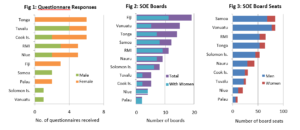Survey of Women's Representation on SOE Boards in Forum Island Countries (FEMM)
Meeting Papers
06 July 2013
- Home
- Publications
- Survey of Women's Representation On SOE Boards In Forum Island Countries (FEMM)
FORUM ECONOMIC MINISTERS MEETING AND FORUM ECONOMIC OFFICIALS MEETING
Nuku’alofa, Tonga 3 – 5 July, 2013SESSION 3: EMPOWERING WOMEN, EMPOWERING DEVELOPMENT
SURVEY OF WOMEN’S REPRESENTATION ON SOE BOARDS IN FORUM ISLAND COUNTRIES
[PIFS(13)FEMT.11] This paper provides an update to Ministers on the work currently being undertaken by the Pacific Islands Forum Secretariat on improving gender participation on SOE boards in the Pacific. For discussion.Purpose
This paper provides an update to Ministers on the work currently being undertaken by the Forum Secretariat on improving gender participation on State Owned Enterprise (SOE) boards in Forum Island Countries (FICs).Background
- In the 2011 Waiheke Declaration on Sustainable Economic Development, Forum Leaders affirmed the importance of the private sector in helping realise the region’s potential, and pledged to foster an environment that supports increased investment, productive activity and a strengthened private sector. They committed specifically to increase opportunities for women to participate in the formal labour market and as entrepreneurs, being one aspect of increasing women’s economic empowerment.
- Forum Economic Ministers, at their meeting in 2012 directed that the Forum Secretariat, in collaboration with relevant development partners, assist FICs to improve the enabling environment for women’s economic participation, and increase opportunities for women to participate in the formal labour market and as entrepreneurs specifically by implementing affirmative action/equal opportunity employment practices in public sector employment practices, including SOE and statutory boards, to increase the proportion of women in senior positions.
Issues
- The Forum Secretariat in collaboration with UN Women has conducted a survey responding to the 2012 FEMM directive that the Forum Secretariat assists FICs to improve the enabling environment for women’s economic participation. The aim of the survey was to identify the participation of women on SOE boards and possible constraints to women participating on SOE boards.
- The first part of the survey was a mapping exercise conducted on SOE boards across the FICs to determine the participation of women on SOE boards.1 The second part of the survey was a questionnaire intended to gather key information from selected FICs regarding the appointment and tenure practices, education and experience, and personal commitment of board members. The survey is ongoing, and a final report at the conclusion of the survey will be released later in 2013. However, some preliminary findings from the survey are outlined below.
- The survey team has experienced significant difficulty in acquiring information and receiving feedback on the questionnaire. The questionnaire responses to date are low with a total of 37 responses (22 from women and 15 from men). The follow-up for the survey relied heavily on information provided by contacts in each country that were either working in the area of gender empowerment, or were Forum Desk Officers (in the case of the Small Island States). However, in two countries, in-country contacts could not be established, therefore they could not be included in the mapping exercise. Similarly in one country, there were significant resource constraints and it could not be included in the survey. The Forum Secretariat was also advised by one country that the information requested by the survey questionnaire was deemed sensitive and thus requested its exclusion from the study.
- The preliminary findings suggest that the majority of FICs included in the study have low levels of representation of women on SOE boards. The mapping exercise found that while the number of SOEs that have women sitting on their boards is relatively high (See Figure 2), the actual number of board seats that are occupied by women is low (see Figure 3). Many women also sit on multiple boards which mean that the actual number of women who are on the boards is even lower.

- Results from the questionnaire survey show that female board members have higher levels of formal education relative to the male board members and this may be attributed to the majority of the women surveyed indicating that they are primarily involved in white collar employment which requires higher levels of formal education. When considering the other measure of ability which is work experience, the results also show that younger and less experienced women are being selected to SOE boards. Furthermore the results show that women have a much lower turnover rate than men, and more women sit on multiple SOE boards than men.
- These preliminary findings indicate that some progress is being achieved with the affirmative action initiatives that have been undertaken across the FICs to promote more women to leadership positions such as members of SOE boards. It is noted that the majority of the appointments are by the State or Government. However the results of the study also indicate that there are not enough women being appointed to SOE Labour force data from each FIC shows that women are participating in increasing numbers in the formal economy2, but this is not reflected in women’s participation on SOE boards.
- Further work needs to be done to supplement and expand on the findings of this survey. In particular, focus should be placed on looking at the career progression of women in the labour market as this may be a limiting factor for women’s participation in leadership positions. It is also important that this survey has a full coverage of all the FICs.
Resource Implications
- To support the implementation of the recommendations, additional resources for, and improved coordination of, key regional and technical agencies (such as, the Forum Secretariat, UN Women, and Secretariat of the Pacific Community) on gender initiatives are needed.
Pacific Islands Forum Secretariat
Suva
June 2012
Explore other publications

Media Releases and News
15 October 2024

Statements
14 October 2024

Remarks and Speeches
10 October 2024